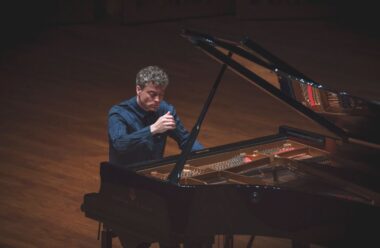 United Kingdom Beethoven, Mozart, Brahms, Schubert: Paul Lewis (piano). Turner Sims Live performance Corridor, Southampton, 22.4.2025. (CK)
United Kingdom Beethoven, Mozart, Brahms, Schubert: Paul Lewis (piano). Turner Sims Live performance Corridor, Southampton, 22.4.2025. (CK)

Beethoven – Piano Sonata in C minor, Op.10 No.1
Mozart – Piano Sonata in C, K330
Brahms – Three Intermezzi, Op.117
Schubert – Piano Sonata No.18 in G, D894
The Turner Sims’s fiftieth anniversary season has seen some memorable concert events by returning artists – all of them welcome, and maybe none extra so than Paul Lewis, who handled a full home to a considerable programme of music by 4 giants of the Austro-German repertory. He was initially intending to shut the recital with Beethoven’s final Sonata, the C minor, Op.111; however the remaining results of his accident (a automotive drove into him in a Tesco automotive park in January) dictated its alternative by Schubert’s G main Sonata, D894.
We did, actually, start with a Beethoven Sonata in C minor, although a a lot earlier one: the primary of the three Op.10 Sonatas. Like its successor, the Sonata in F, it tends to reside within the shadow of the better-known Op.10 No.3 in D: however it was instantly clear, as Lewis plunged straight in with steely vitality, that the younger Beethoven meant enterprise. Captivatingly, the strict strains of the opening theme melted, in Lewis’s palms, into the swish second theme. The Adagio molto started with a easy phrase that appeared to open like a flower; Lewis gave it air and led us by a sequence of light transformations earlier than sustaining a great steadiness of wit, grace and energy within the finale. There was sufficient right here to trace at Beethoven’s greatness on this key: the Sonata Pathétique was simply across the nook, the Fifth Symphony a decade away.
I sometimes have the sensation, after the opening merchandise of a live performance, that coronary heart and thoughts are already full: that few would really feel short-changed if all of us went dwelling. This isn’t one of many nice sonatas, however Lewis’s efficiency made me really feel this fashion.
In related vein, Lewis subsequent gave us a Mozart piano sonata – K330 – overshadowed by others in its group (K330-333), written within the composer’s early twenties. The chance was that it’d sound moderately light-weight after Beethoven: however in Lewis’s palms the music’s lightness and pellucid readability had been as refreshing as early morning sunshine. The lyricism of the Andante cantabile appeared ahead to Schubert; the playful Allegretto finale sparkled like a glass of champagne, with beaded bubbles winking on the brim.
It was most likely sensible to position the interval right here, earlier than we moved to the autumnal shades of Brahms’s Intermezzi, Op.117. The primary, Andante moderato, is a Berceuse whose radiant simplicity touches sublimity; the second’s rippling movement ranges extra broadly earlier than evaporating mysteriously. We sense ache within the stressed minor-key figuration of the third; there’s balm within the long-limbed lyricism of the major-key central part, however a Schubertian melancholy on the shut. Lewis’s delicate taking part in admitted us to a small world in each bit.
And so to Schubert himself. Each cloud has a silver lining. When Lewis introduced the second instalment of his Schubert Sonatas sequence to the Turner Sims (in Could 2023), I ended my evaluate ‘If Paul Lewis comes again in a number of months to play the D894 I can be first in line’. He did, and I missed it, lamenting in my evaluate of the fourth and remaining instalment (in March 2024) that ‘I’m nonetheless kicking myself for lacking the third instalment (with the fantastic G main Sonata D894)’. I’m stopping properly wanting saying that his accident, and the ensuing change of programme, suited me superb: however as a lover of this sonata there’s a contact of the serendipitous about my second probability to listen to him play it.
Many commentators have written of the work’s ‘mysterious serenity’, its presiding spirit of autumnal gentleness within the face of sickness and the younger composer’s realisation that his life can be minimize brief, its nature as a gateway to the late masterpieces. Its very opening, echoing the equally magical starting of Beethoven’s G main Piano Concerto, establishes this temper: it’s not with out rigidity and battle, however we sense – on this work no less than – that the tip can be peace.
Paul Lewis’s efficiency was completely unmannered: no varnish was utilized. It wasn’t a gradual efficiency, however every part was given air and area as we had been taken on Schubert’s inward journey. There have been passages of highly effective drama, extensive vistas, and a beautiful delicacy and poise; magical modifications of key, shifts of perspective, shafts of daylight. I really feel very lucky to have heard Lewis on this music; and I look ahead to the time when he revisits the late sonatas of Beethoven. That point will certainly come.
Chris Kettle